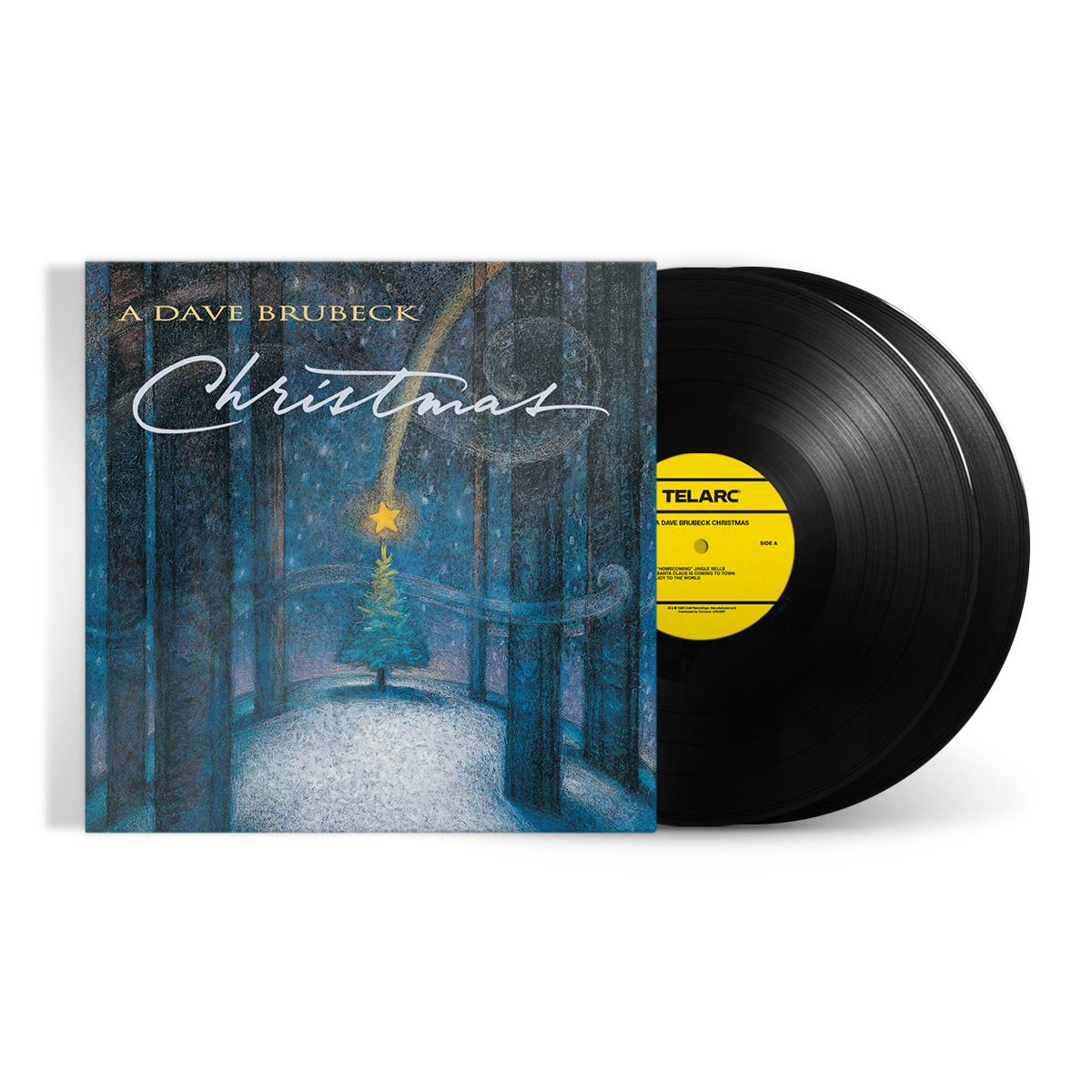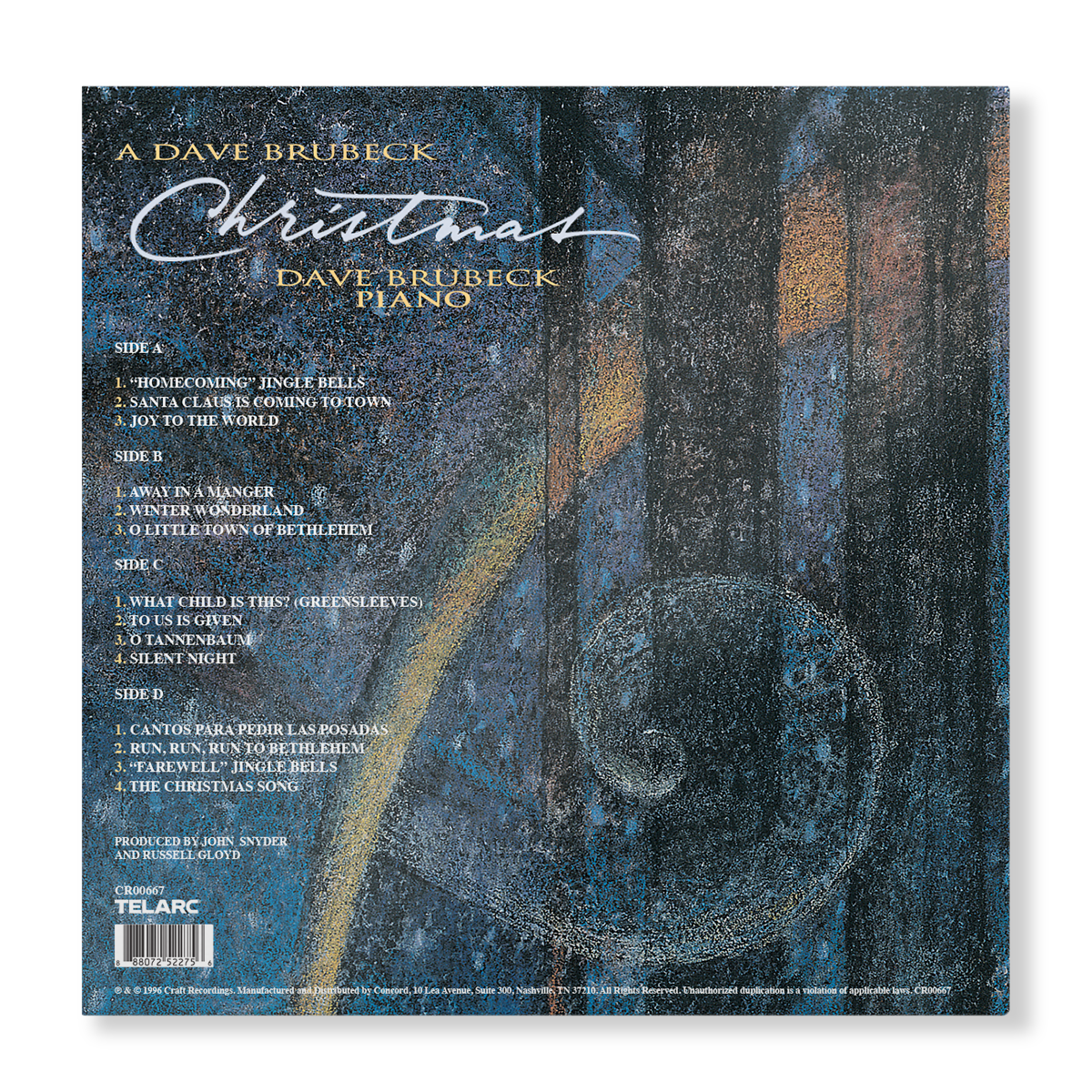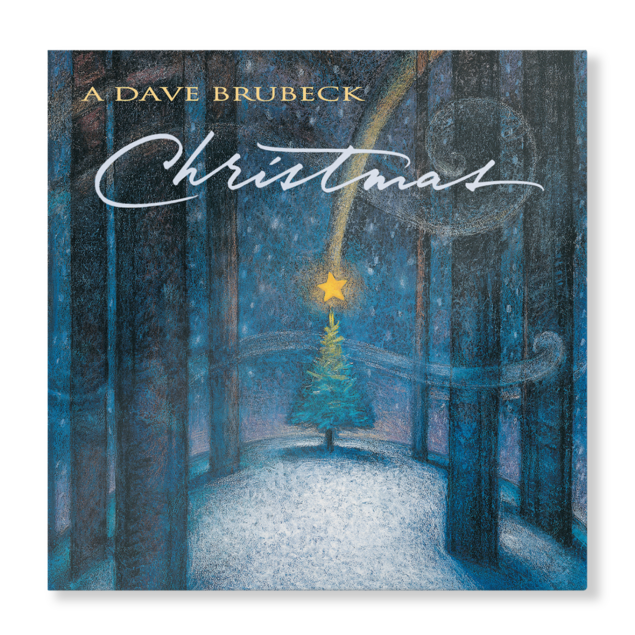"A Dave Brubeck Christmas" Reissued at 45 RPM
Brubeck's Christmas Album Combats Crass Holiday Commercialization
It’s that time of the year again. The holidays take so long to arrive and then disappear far too quickly. Most music lovers have a complicated relationship with the sounds of the season. While some folks can’t wait for their local radio stations to switch over to an all holiday music format, others - myself included - find ourselves thoroughly exhausted by those relentless playlists come December 26th. It’s not that there’s a problem with holiday music because there isn’t; like any format, it has its time and place; and - like any genre - some of it is good, and some of it is...y’now.
The problem lies in the inundation of a very limited playlist of Christmas music that functions as white noise to anyone tuned in to the sound around them. Fortunately (and unfortunately because one rarely gets to hear it) there is a vast array of wonderful holiday/Christmas music that never gets airtime on your favorite radio station (or in your preferred grocery store aisle). So, why not try something different?
This season, Craft Recordings dives into the Telarc catalog from 1996 and revisits Dave Brubeck’s, A Dave Brubeck Christmas which finds the jazz giant nearing the end of his career with a yearning to return to his favorite works associated with the winter season. His approach is that of a beautifully minimalist Christmas tree, unadorned with superfluous trinkets and tinsel. For those familiar with Brubeck’s large catalog, you’ll note that during a career that spanned six decades, he did not release an album of Christmas music until this one.
 This 2-LP edition is the second time the album has appeared on vinyl. The first version - a single disc - was released in 2014 with a mastering by Paul Blakemore at Concord Mastering and pressed at Rainbo. For this version, however, the lacquers were cut at 45 RPM by Ryan Smith at Sterling Sound and both discs were pressed on 180-gram vinyl.
This 2-LP edition is the second time the album has appeared on vinyl. The first version - a single disc - was released in 2014 with a mastering by Paul Blakemore at Concord Mastering and pressed at Rainbo. For this version, however, the lacquers were cut at 45 RPM by Ryan Smith at Sterling Sound and both discs were pressed on 180-gram vinyl.
A Dave Brubeck Christmas was produced and recorded in a direct fashion. It was just Dave and a piano at Ambient Recording Studio located in Stamford, CT where most tracks were captured in one take. Recorded over the course of two days in the very un-Christmassy month of June, the album was produced by John Snyder and Russell Gloyd. The liner notes reveal technical details that an audiophile reader may find of interest: microphones were omnidirectional B&K 4006s and the album was also recorded on the Telarc/UltraAnalog Tandem 20-bit ADC.
Brubeck begins his Christmas journey with a pleasantly buoyant “‘Homecoming’ Jingle Bells’” and quickly compliments the mood with “Santa Claus is Coming to Town”, which is spiked with the splashy bounce you might expect to hear upon entering your favorite piano bar for a holiday cocktail hour: one can almost hear imagined glasses clink while bursts of laughter compete while Brubeck struggles to be heard above the jovial fray. “Joy to the World” is anchored on a droning root note, the familiar carol which is quick and to the point with plenty of joyful arpeggiating. “Away in a Manger” signals a change in the album’s pace as the pianist approaches this number with sacred restraint.
There is one last holiday favorite for Brubeck to belt out before he alters the tone of the rest of the album, “Winter Wonderland” strides in providing plenty of boisterous nuance to this cheery classic. The perkiness of the first few tracks fade into the distance as the jazz maven approaches some of his favorite holiday music in an increasingly meditative tone. The second act begins with a wistful and intimate recording of “O Little Town of Bethlehem” with delicate playing which the recording displays with ease. Here, listeners have an opportunity to appreciate Brubeck’s playing without the weight of excessive reverb or other distracting sonic treatments: this track is also a reminder that this project highlights only a man and his piano; nothing more.
There are also two Dave Brubeck originals, “To Us Is Given” and “Run, Run, Run to Bethlehem.” The first track is a peacefully pensive and explores chordal transitions. The latter tune is a beautiful original brimming with the twinkle of a clear winter night’s sky. At moments, it is nearly classical in form while repeating the song’s melodic motif in alternating styles and tempos. It also adds a much needed step of pep to the latter part of the album.
On “O Tannenbaum” and “Silent Night” Brubeck’s approach remains relatively steady as it does throughout the rest of the album, faultlessly segueing from one tune to the next in a similar tempo and approach. “Silent Night” in particular takes on an improvisational path of its own while still returning to the melody we’re all familiar with.
 Disc 2 is a touch off-center which - on a rock and roll LP wouldn’t be a cause for concern - however, here - with Brubeck’s piano in full sonic view - it’s hard not to notice the slight warbles on certain passages, specifically those with sustaining notes. The same is true of the vinyl’s noisiness (again, mostly on disc 2 - side D). Because of the stark nature of the recording, the record’s surface noise on my copy can be a bit distracting; there are pops and clicks throughout. Again, were this a different recording, it might not have been an issue, but the presentation of this set is best served up with a jet black, noise-free background for full appreciation of Brubeck’s nuanced keyboard offerings.
Disc 2 is a touch off-center which - on a rock and roll LP wouldn’t be a cause for concern - however, here - with Brubeck’s piano in full sonic view - it’s hard not to notice the slight warbles on certain passages, specifically those with sustaining notes. The same is true of the vinyl’s noisiness (again, mostly on disc 2 - side D). Because of the stark nature of the recording, the record’s surface noise on my copy can be a bit distracting; there are pops and clicks throughout. Again, were this a different recording, it might not have been an issue, but the presentation of this set is best served up with a jet black, noise-free background for full appreciation of Brubeck’s nuanced keyboard offerings.
Of course, the discs were cleaned, as was my stylus. However, I was a bit surprised at the prominence of the background noise and even went so far as to spin another solo piano record to make sure the fault wasn’t my own. I reached for Glenn Gould’s 1983 Grammy award winning recording, Beethoven: Piano Sonatas Nos. 12 & 13 (M 37831). While the background wasn’t the absolute word in silence, it was better, leaving plenty of room for Glenn’s accompanying humming. The tracks on this 40 year old album were even sparser than the Brubeck record - containing moments of complete silence - especially “Sonata No. 13,Op. 27, No. 1.” Also, of interest were the qualities of the piano recordings here: much more mid-range and high frequencies were present as compared with Brubeck’s piano which is big and dark; underscoring more of the instrument’s bass frequencies, particularly prominent on “What Child is This” (Greensleeves)” and “Silent Night”. While the liner notes detail the individual who “prepared” the piano - and even the company who provided the piano to the studio - it does not specify the instrument’s make, or model.
The album’s closing comes full circle as Brubeck revisits a track from earlier on the record albeit with a much different arrangement: “‘Farewell’ Jingle Bells” is beautiful, but also touched with an icy dissonance. The final track on the album, “The Christmas Song” is almost hymnlike; here Brubeck strikes the perfect balance of rumination and encouraging optimism; it sounds like the end of the good party as guests amble back to their cars over a snowy path.
Brubeck’s musical vision of the holidays just might influence your state of mind during this season, no matter what holiday you celebrate. This record is even radical in a sense, in that it not only avoids the creepy commercialist version of Christmas that we’ve become accustomed to; it obliterates it. Brubeck is only slightly interested in the glitter and glitz of the season, he’s primarily focused upon the stark winter landscape that appears out of the window as the sun sets early on a late mid-week winter’s afternoon. It mostly sets aside a sprightly holiday step in favor of bare branches and a cutting gust of wind. It’s not only a roaring fireplace, but rather it can also be a solitary and silent walk to the curb on a cold and dark garbage night. It’s not only a party of clinking glasses, it’s also a midnight memory of those who have left us, memories of holidays past that we can try to recreate, but which have vanished forever. Perhaps this can be summed up by simply looking at the beautiful cover art by Greg Couch: it’s dark and cold, but at its heart, there burns an undeniable warmth.
 And that’s not by accident, Brubeck’s Christmas vision is not secular, it’s a Christian one and subscribers to Christian religions of the world will appreciate the musical context here on another spiritual level. To those believers, the album’s juxtaposition of light and darkness will be familiar themes of the season. Brubeck explains further in his liner notes, “The exciting trappings of Christmas - decorations, lights, food, parties, Rudolph and Santa Claus, holly and mistletoe, Sunday school pageants, shepherds and angels - can be, at times, tinged with peaceful solemnity, if one quietly lights a candle and ponders the mystery of His birth.”
And that’s not by accident, Brubeck’s Christmas vision is not secular, it’s a Christian one and subscribers to Christian religions of the world will appreciate the musical context here on another spiritual level. To those believers, the album’s juxtaposition of light and darkness will be familiar themes of the season. Brubeck explains further in his liner notes, “The exciting trappings of Christmas - decorations, lights, food, parties, Rudolph and Santa Claus, holly and mistletoe, Sunday school pageants, shepherds and angels - can be, at times, tinged with peaceful solemnity, if one quietly lights a candle and ponders the mystery of His birth.”
A Dave Brubeck Christmas is mostly serious and austere, things that should be parts of our regular holiday diet. Too much cake and candy - or, other indulgences - and we get tummy aches. This holiday, consider Brubeck’s holiday detox; it’s a no-frills excursion in search of the true meaning of the season.












































